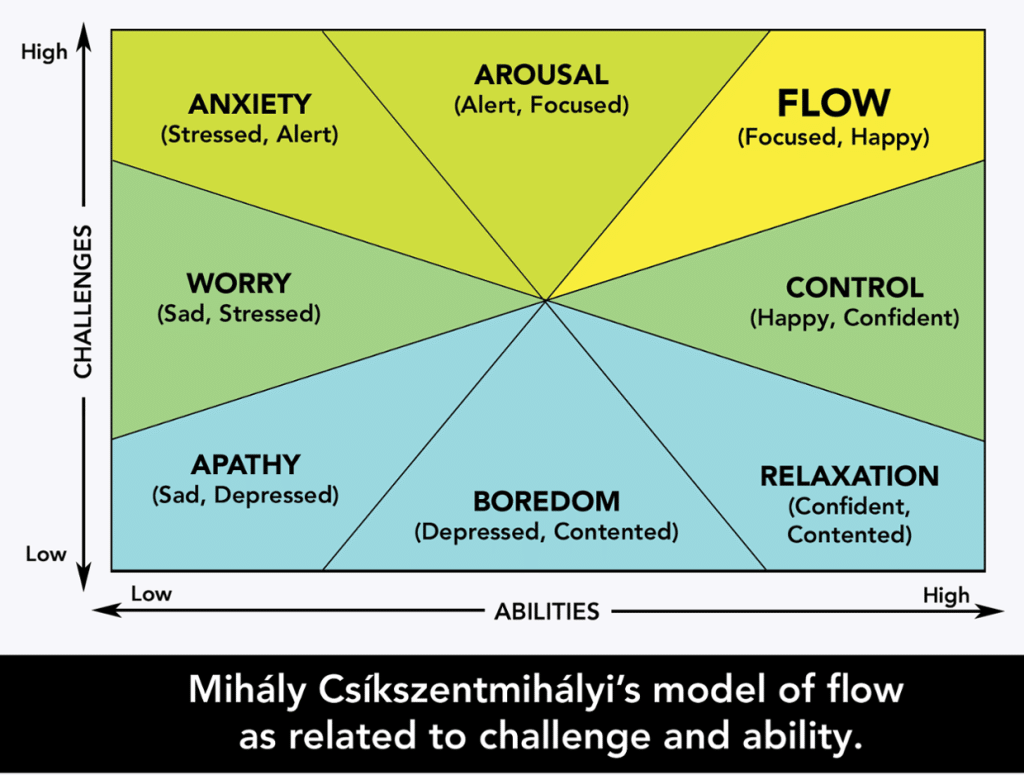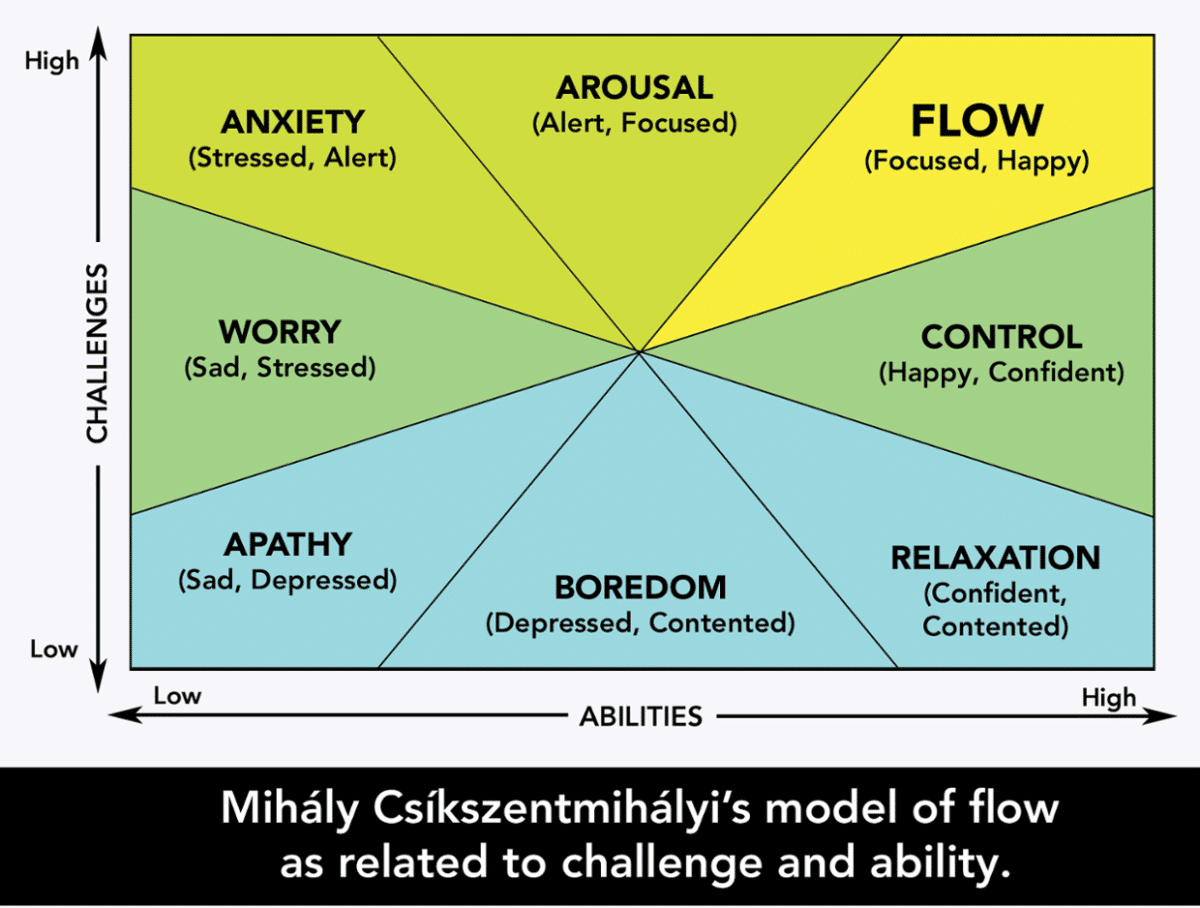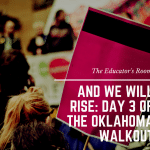Overview:
Active learning is critical for students to actually learn the materials. This article focuses on how to get students to that flow.
We’ve all been there. That moment when you’re completely absorbed in the experience. You’re in active learning- the zone. You’re somehow calm, focused, and intense all at the same time. You’re like Scrooge at the end of A Christmas Carol, “I am as light as a feather, I am as happy as an angel, I am as merry as a schoolboy. I am as giddy as a drunken man.” Well, maybe not quite like that, but you get the idea. Hungarian psychologist Mihaly Csikszentmihalyi coined this psychological state of mind as flow, in which outside stimuli, including time itself, seem to fall away as you completely immerse yourself into an activity.
States of Mind: Flow

Lucky for us, he also created a diagram to describe other states of mind that occur in relation to flow. For example, I’ve often described playing drums in my country/blues band as meditative. I’m with friends, playing good music, feeling like an audience member and a participant. But, I’ve also described the experience as teetering on boredom. Why? Because in that band, my job is to play less, keep a simple rhythm, and stay out of the way. While this is tasteful and appropriate, one might consider me underutilized.
On the other hand, I often find myself in a flow state when I’m recording my music in the studio. As I play the particular drum, guitar, or bass parts over and over again, I become more relaxed, focused, and intentional about all aspects of the performance. My skill and the challenge of capturing the perfect performance are equally high.
Active v. Passive Learning
Imagine, then, that my music experiences are analogous to classroom learning. In the “band” classroom, I’m a passive and/or compliant learner. In my studio projects, I’m an active learner. My role in each is heavily determined by the level of challenge I encounter. And, yet, I continue to participate in both because, together, these experiences help me work well with others, find joy in low-level challenges, refine my skills, daydream, create, set goals, plan, problem-solve, persist, and perform in a variety of settings, with a variety of people, in a variety of ways.
Active Learning
As educators, we are all “band leaders” orchestrating our classrooms! Consider how your instructional practices influence your players! In the article Springing Into Active Learning (Zmuda, 2008), it is suggested that students often toggle between compliant vs. engaged learning. “…compliant learners typically restrict themselves to answering the question the teacher asked, whereas engaged learners tend to raise additional questions, delve more deeply into thinking, or offer another point of view (Zmuda, 2008).” The article goes on to identify common beliefs about classroom learning and how to combat them. In the chart below, I have summarized some of the beliefs mentioned in the article and offered my own recommendations for action-steps that may shift the environment into one that encourages active learning.
| Student Belief | Teacher Action Step |
| Teachers set the rules/expectations. | Base rules/expectations on the particular discipline and/or profession. Be intentional and transparent. |
| Answers need to be teacher approved. | Focus on reasoning over correctness. Rather than respond with “good” or “yes,” try shifting to “thanks” or “why do you think that?” |
| Assignments are busy work. | Move away from strict deadlines, monotonous practice, and routine tasks. Make each assignment meaningful, purposeful, and reflective. |
| Mistakes need to be fixed. | Treat mistakes as windows into thinking. There’s often a good idea behind a wrong answer. |
| The grade determines the value of the work. | Give opportunities for reflection and revision. A grade is momentary. The quality of work can continue to grow. |
| School work is distinct from real life. | Choose authentic, open-ended tasks. Offer voice, choice, and multiple pathways. Embrace project-based learning. |
Active Learning in Math
As a math instructional coach, I offer more subject-specific recommendations to the teachers I work with. For example, the Common Core contains both content and practice standards. “The Standards for Mathematical Practice describe ways in which developing student practitioners of the discipline of mathematics increasingly ought to engage with the subject matter as they grow in mathematical maturity and expertise throughout the elementary, middle and high school years.” As such, the general action steps I’ve listed above are spelled out more specifically for the subject of math to help teachers set rules/expectations that are discipline-specific. I’m aware that other subject areas offer similar types of practice standards to assist in creating an active learning environment.
I believe if we make an effort to shift our classrooms into environments that promote active learning, then the opportunities for students to experience flow will come naturally and much more often. Imagine reinforcing practices such as “productive struggle” or “grit” in the context of an authentic open-ended task, with built-in feedback-revision cycles, to improve the overall quality of the intended product. Imagine further that your students are well underway to create their potential solution and/or final product and you’ve just offered them some relevant feedback that you’d like them to incorporate. Your next move would be to simply walk away, give them space to work, and watch them flow!






